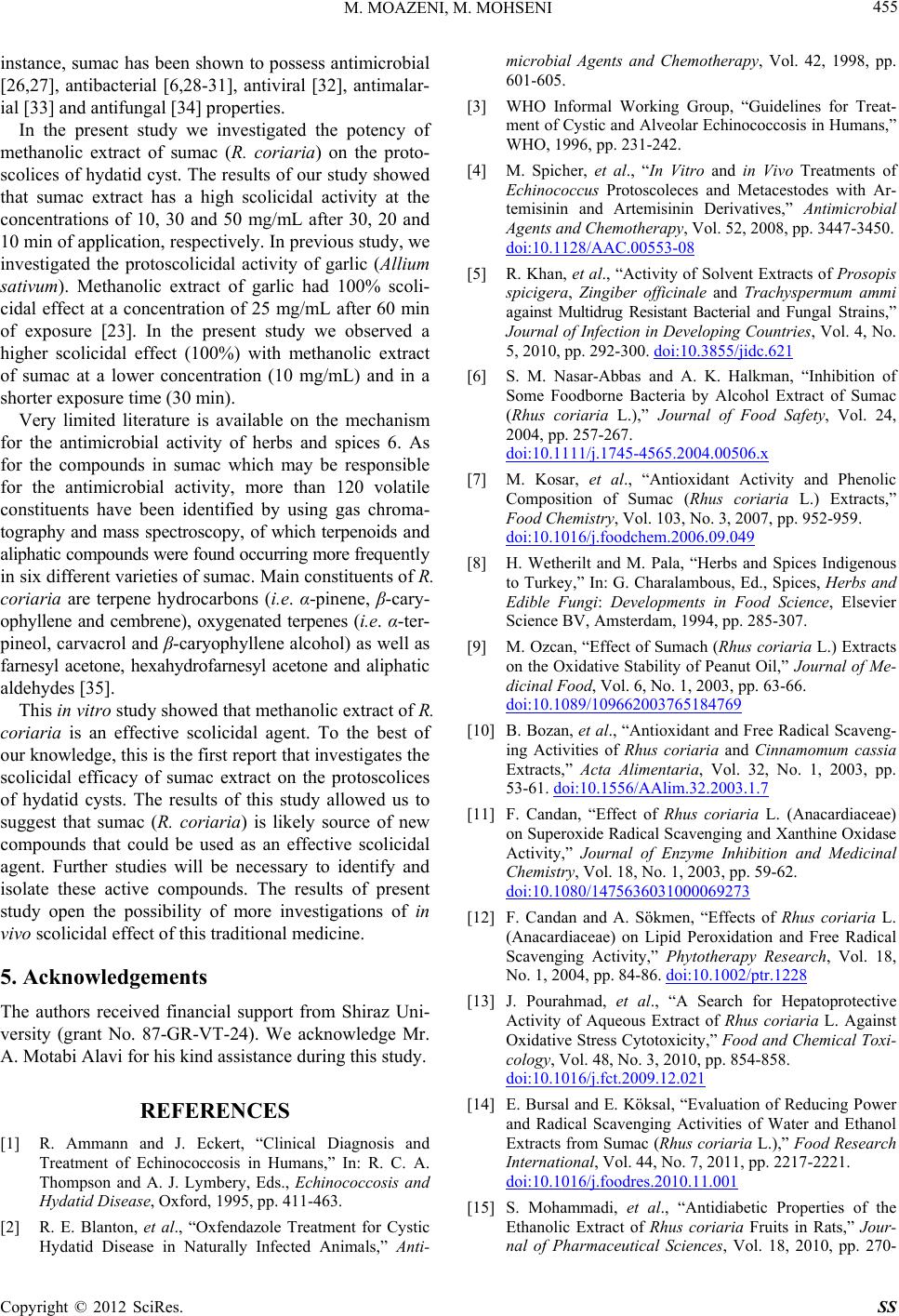
M. MOAZENI, M. MOHSENI 455
instance, sumac has been shown to possess antimicrobial
[26,27], antibacterial [6,28-31], antiviral [32], antimalar-
ial [33] and antifungal [34] properties.
In the present study we investigated the potency of
methanolic extract of sumac (R. coriaria) on the proto-
scolices of hydatid cyst. The results of our study showed
that sumac extract has a high scolicidal activity at the
concentrations of 10, 30 and 50 mg/mL after 30, 20 and
10 min of application, respectively. In previous study, we
investigated the protoscolicidal activity of garlic (Allium
sativum). Methanolic extract of garlic had 100% scoli-
cidal effect at a concentration of 25 mg/mL after 60 min
of exposure [23]. In the present study we observed a
higher scolicidal effect (100%) with methanolic extract
of sumac at a lower concentration (10 mg/mL) and in a
shorter exposure time (30 min).
Very limited literature is available on the mechanism
for the antimicrobial activity of herbs and spices 6. As
for the compounds in sumac which may be responsible
for the antimicrobial activity, more than 120 volatile
constituents have been identified by using gas chroma-
tography and mass spectroscopy, of which terpenoids and
aliphatic compounds were found occurr ing more freq u e n t l y
in six different varieties of sumac. Main constituents of R.
coriaria are terpene hydrocarbons (i.e. α-pinene, β-cary-
ophyllene and cembrene), oxygenated terpenes (i.e. α-ter-
pineol, carvacrol and β-caryophyllene alcohol) as well as
farnesyl acetone, hexahydrofarnesyl acetone and aliphatic
aldehydes [35].
This in vitro study showed that methano lic ex tract of R.
coriaria is an effective scolicidal agent. To the best of
our knowledge, this is the first report that investigates the
scolicidal efficacy of sumac extract on the protoscolices
of hydatid cysts. The results of this study allowed us to
suggest that sumac (R. coriaria) is likely source of new
compounds that could be used as an effective scolicidal
agent. Further studies will be necessary to identify and
isolate these active compounds. The results of present
study open the possibility of more investigations of in
vivo scolicidal effect of this traditional medicine.
5. Acknowledgements
The authors received financial support from Shiraz Uni-
versity (grant No. 87-GR-VT-24). We acknowledge Mr.
A. Motabi Alavi for his kind assistance during this study.
REFERENCES
[1] R. Ammann and J. Eckert, “Clinical Diagnosis and
Treatment of Echinococcosis in Humans,” In: R. C. A.
Thompson and A. J. Lymbery, Eds., Echinococcosis and
Hydatid Disease, Oxford, 1995, pp. 411-463.
[2] R. E. Blanton, et al., “Oxfendazole Treatment for Cystic
Hydatid Disease in Naturally Infected Animals,” Anti-
microbial Agents and Chemotherapy, Vol. 42, 1998, pp.
601-605.
[3] WHO Informal Working Group, “Guidelines for Treat-
ment of Cystic and Alveolar Echinococcosis in Humans,”
WHO, 1996, pp. 231-242.
[4] M. Spicher, et al., “In Vitro and in Vivo Treatments of
Echinococcus Protoscoleces and Metacestodes with Ar-
temisinin and Artemisinin Derivatives,” Antimicrobial
Agents and Chemotherapy, Vol. 52, 2008, pp. 3447-3450.
doi:10.1128/AAC.00553-08
[5] R. Khan, et al., “Activity of Solvent Extracts of Prosopis
spicigera, Zingiber officinale and Trachyspermum ammi
against Multidrug Resistant Bacterial and Fungal Strains,”
Journal of Infection in Developing Countries, Vol. 4, No.
5, 2010, pp. 292-300. doi:10.3855/jidc.621
[6] S. M. Nasar-Abbas and A. K. Halkman, “Inhibition of
Some Foodborne Bacteria by Alcohol Extract of Sumac
(Rhus coriaria L.),” Journal of Food Safety, Vol. 24,
2004, pp. 257-267.
doi:10.1111/j.1745-4565.2004.00506.x
[7] M. Kosar, et al., “Antioxidant Activity and Phenolic
Composition of Sumac (Rhus coriaria L.) Extracts,”
Food Chemistry, Vol. 103, No. 3, 2007, pp. 952-959.
doi:10.1016/j.foodchem.2006.09.049
[8] H. Wetherilt and M. Pala, “Herbs and Spices Indigenous
to Turkey,” In: G. Charalambous, Ed., Spices, Herbs and
Edible Fungi: Developments in Food Science, Elsevier
Science BV, Amsterdam, 1994, pp. 285-307.
[9] M. Ozcan, “Effect of Sumach (Rhus coriaria L.) Extracts
on the Oxidative Stability of Peanut Oil,” Journal of Me-
dicinal Food, Vol. 6, No. 1, 2003, pp. 63-66.
doi:10.1089/109662003765184769
[10] B. Bozan, et al., “Antioxidant and Free Radical Scaveng-
ing Activities of Rhus coriaria and Cinnamomum cassia
Extracts,” Acta Alimentaria, Vol. 32, No. 1, 2003, pp.
53-61. doi:10.1556/AAlim.32.2003.1.7
[11] F. Candan, “Effect of Rhus coriaria L. (Anacardiaceae)
on Superoxide Radical Scavenging and Xanthine Oxidase
Activity,” Journal of Enzyme Inhibition and Medicinal
Chemistry, Vol. 18, No. 1, 2003, pp. 59-62.
doi:10.1080/1475636031000069273
[12] F. Candan and A. Sökmen, “Effects of Rhus coriaria L.
(Anacardiaceae) on Lipid Peroxidation and Free Radical
Scavenging Activity,” Phytotherapy Research, Vol. 18,
No. 1, 2004, pp. 84-86. doi:10.1002/ptr.1228
[13] J. Pourahmad, et al., “A Search for Hepatoprotective
Activity of Aqueous Extract of Rhus coriaria L. Against
Oxidative Stress Cytotoxicity,” Food and Chemical Toxi-
cology, Vol. 48, No. 3, 2010, pp. 854-858.
doi:10.1016/j.fct.2009.12.021
[14] E. Bursal and E. Köksal, “Evaluation of Reducing Power
and Radical Scavenging Activities of Water and Ethanol
Extracts from Sumac (Rhus coriaria L.),” Food Research
International, Vol. 44, No. 7, 2011, pp. 2217-2221.
doi:10.1016/j.foodres.2010.11.001
[15] S. Mohammadi, et al., “Antidiabetic Properties of the
Ethanolic Extract of Rhus coriaria Fruits in Rats,” Jour-
nal of Pharmaceutical Sciences, Vol. 18, 2010, pp. 270-
Copyright © 2012 SciRes. SS